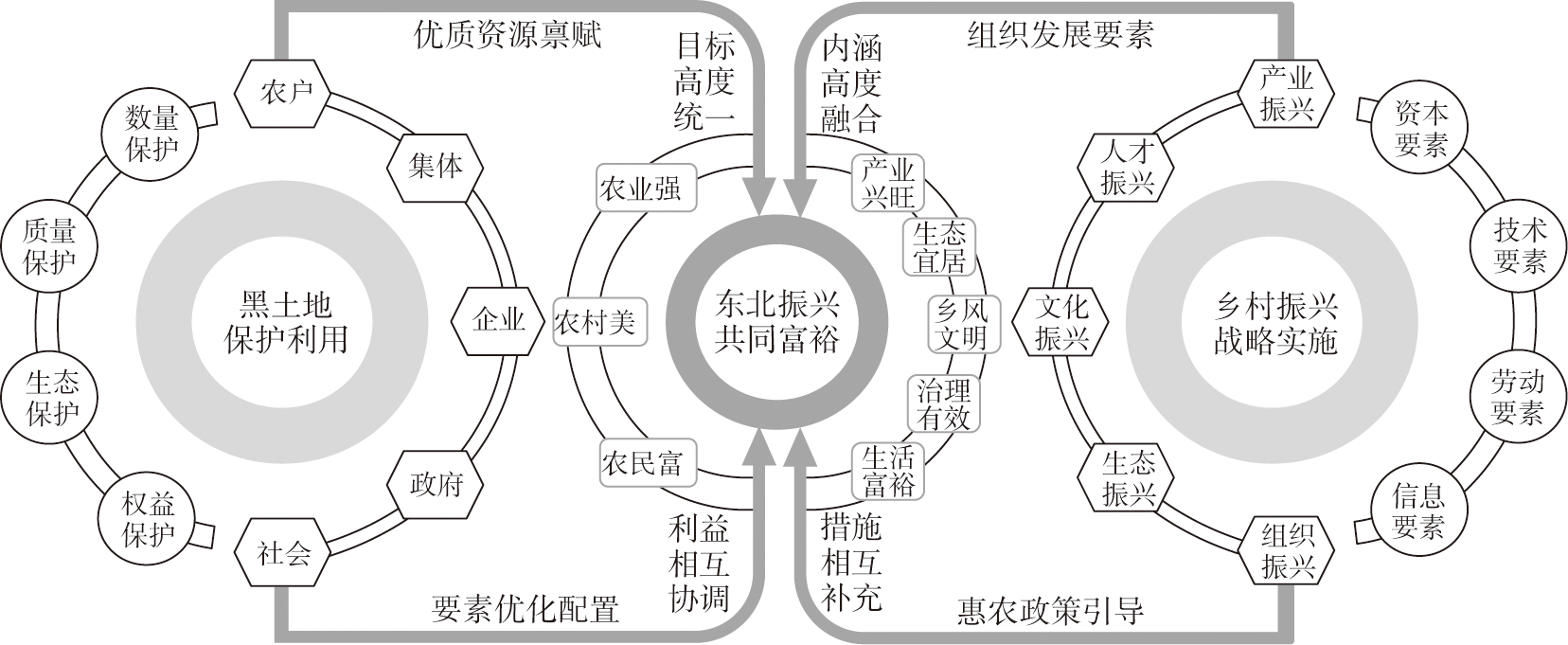

东北地区黑土地保护利用与乡村振兴的融合机理及互馈理路研究——基于典型村庄的过程追踪调查
|
李政宏(2001- ),男,河北衡水人,硕士,研究方向为耕地保护与乡村振兴。E-mail: lizhenghong1005@163.com |
收稿日期: 2023-10-07
修回日期: 2023-12-04
网络出版日期: 2024-05-11
基金资助
国家自然科学基金项目(42071226)
国家自然科学基金项目(42261144750)
国家自然科学基金项目(42371292)
The integration mechanism of black soil protection and rural revitalization in Northeast China and their mutual feeding path: A process tracking investigation based on typical villages
Received date: 2023-10-07
Revised date: 2023-12-04
Online published: 2024-05-11
化解东北地区乡村贫困与黑土地退化高度重叠问题,需探索统筹实施黑土地保护利用与乡村振兴的系统策略,发现其背后的因果关系。在解析东北地区黑土地保护利用与乡村振兴二者间融合机理的基础上,运用过程追踪法对典型案例村庄开展调查,厘清二者间的互馈理路,明晰内在因果传导路径。研究发现:(1)二者在目标上高度统一、内涵上高度融合、利益上相互协调、措施上相互补充;(2)从驱动机制、链接机制、助推机制解析二者间的互馈理路,要求推动要素层整合优化、政策层中介链接、资源层转化提升;(3)要素驱动型、政策主导型、资源赋能型三类村庄发展历程具有差异化的因果传导路径。需从保护黑土资源本底、加快生产要素驱动、健全政策统筹机制、采取差异化发展路径四个方面支撑二者统筹发展。

李政宏 , 吕晓 , 徐畅 , 牛善栋 , 王亚男 . 东北地区黑土地保护利用与乡村振兴的融合机理及互馈理路研究——基于典型村庄的过程追踪调查[J]. 自然资源学报, 2024 , 39(5) : 1193 -1207 . DOI: 10.31497/zrzyxb.20240513
To solve the problem of high overlap between rural poverty and black soil degradation in Northeast China, it is necessary to explore the systematic strategy of integrated implementation of black soil protection and utilization and rural revitalization, and find the causal relationship behind it. Based on the analysis of the integration mechanism between the protection and utilization of black soil and rural revitalization in Northeast China, the process tracking method was used to investigate typical villages, clarify the mutual feeding path between the two, and clarify the internal causal transmission paths. The findings are as follows: (1) The two are highly unified in terms of objectives, highly integrated in terms of connotations, coordinated in terms of interests and complementary in terms of measures. (2) Analyze the mutual feeding path among the driving mechanism, linking mechanism and boosting mechanism, requiring to promote the integration and optimization of the factor layer, the intermediary link of the policy layer, and the transformation and improvement of the resource layer. (3) The development process of the three types of villages-factor driven, policy oriented and resource empowered-have differentiated causal transmission paths. The results show that it is necessary to support the overall development of black soil resources from four aspects: protecting the background of black soil resources, accelerating the driving of production factors, perfecting the policy coordination mechanism, and adopting differentiated development paths.

表1 东北地区黑土地保护利用与乡村振兴的因果传导路径Table 1 The causal transmission path between protection and utilization of black soil and rural revitalization in Northeast China |
| 因果传导路径 | 适宜模式 | 基本经验 |
|---|---|---|
| 要素→政策→资源 | 要素驱动型 | ·某一优势生产要素率先注入,在政策引导下配置于黑土资源 ·多用于城郊地区拥有历史文化景观的村庄,易于第三产业发展 |
| 要素←政策→资源 | 政策主导型 | ·政府政策强势主导,征召主体投入生产要素与黑土资源衔接 ·多用于传统农区以粮食生产为主的村庄,易于第一产业发展 |
| 要素←政策←资源 | 资源赋能型 | ·黑土资源优势禀赋发挥,在政策引导下吸引生产要素集聚 ·多用于以特色优势农产品生产为主的村庄,易于第二产业发展 |
| [1] |
吕晓, 赵雲泰, 牛善栋. 擦亮新时代黑土地保护的“底色”. 农民日报, 2021-04-08(3), https://szb.farmer.com.cn/2021/20210408/20210408_003/20210408_003_1.htm.
[
|
| [2] |
葛全胜, 王介勇, 朱会义. 统筹推进黑土地保护与乡村振兴: 内在逻辑、主要路径及政策建议. 中国科学院院刊, 2021, 36(10): 1175-1183.
[
|
| [3] |
赵玉明, 程立平, 梁亚红, 等. 东北黑土区演化历程及范围界定研究. 土壤通报, 2019, 50(4): 765-775.
[
|
| [4] |
贾鹏丽, 冯海艳, 李淼. 东北黑土区不同土地利用方式下农田土壤微生物多样性. 农业工程学报, 2020, 36(20): 171-178.
[
|
| [5] |
邓祥征, 梁立, 廖晓勇, 等. 国际粮食贸易影响下东北黑土地生产压力变化与保护策略. 自然资源学报, 2022, 37(9): 2209-2217.
[
|
| [6] |
许文旭, 杨献坤, 崔斌, 等. 东北黑土区典型坡耕地土层厚度及退化程度分析. 中国水土保持科学(中英文), 2021, 19(3): 28-36.
[
|
| [7] |
张兴义, 刘晓冰. 中国黑土研究的热点问题及水土流失防治对策. 水土保持通报, 2020, 40(4): 340-344.
[
|
| [8] |
霍海南, 李杰, 袁磊, 等. 秸秆还田量对培肥农田黑土氮素初级转化速率的影响. 应用生态学报, 2020, 31(12): 4109-4116.
[
|
| [9] |
|
| [10] |
王琦琪, 陈印军, 李然嫣. 东北黑土地保护评价指标体系研究. 中国农学通报, 2018, 34(2): 42-47.
[
|
| [11] |
韩晓增, 李娜. 中国东北黑土地研究进展与展望. 地理科学, 2018, 38(7): 1032-1041.
[
|
| [12] |
敖曼, 张旭东, 关义新. 东北黑土保护性耕作技术的研究与实践. 中国科学院院刊, 2021, 36(10): 1203-1215.
[
|
| [13] |
汪景宽, 徐香茹, 裴久渤, 等. 东北黑土地区耕地质量现状与面临的机遇和挑战. 土壤通报, 2021, 52(3): 695-701.
[
|
| [14] |
牛善栋, 吕晓, 谷国政. 感知利益对农户黑土地保护行为决策的影响研究: 以“梨树模式”为例. 中国土地科学, 2021, 35(9): 44-53.
[
|
| [15] |
孟凡杰, 于晓芳, 高聚林, 等. 黑土地保护性耕作发展的制约瓶颈和突破路径. 农业经济问题, 2020, (2): 135-142.
[
|
| [16] |
李然嫣, 陈印军. 东北典型黑土区农户耕地保护利用行为研究: 基于黑龙江省绥化市农户调查的实证分析. 农业技术经济, 2017, (11): 80-91.
[
|
| [17] |
林国栋, 吕晓, 彭文龙, 等. 黑土地保护的实践逻辑及其关键机制分析: 基于典型试点区域的多案例分析. 自然资源学报, 2023, 38(10): 2523-2535.
[
|
| [18] |
王超, 王守臣. 黑土地保护法治化研究: 以吉林省黑土地保护实践为例. 农业经济问题, 2018, (10): 38-45.
[
|
| [19] |
李小丽, 邢玉升. 黑土地保护利用补偿机制研究: 以黑龙江省为例. 学习与探索, 2018, (2): 129-133.
[
|
| [20] |
李政宏, 吕晓, 杨伊涵, 等. 中国黑土地保护政策演进过程与特征的量化考察. 土壤通报, 2022, 53(4): 998-1008.
[
|
| [21] |
何宏莲, 安洋, 刘尊梅. “三位一体”黑土地法律保护的应然逻辑与实现路径. 资源科学, 2023, 45(5): 913-925.
[
|
| [22] |
|
| [23] |
任勇, 周芮. 公共管理研究中的因果过程追踪法应用及其拓展空间. 中国行政管理, 2023, (2): 96-107.
[
|
| [24] |
杜国明, 梁常安, 张树文, 等. 黑土地保护的对象特性、面临形势与应对策略. 资源科学, 2023, 45(5): 887-899.
[
|
| [25] |
|
| [26] |
|
| [27] |
费红梅, 孙铭韩, 王立. 农户黑土地保护性耕作行为决策: 价值感知抑或政策驱动?. 自然资源学报, 2022, 37(9): 2218-2230.
[
|
| [28] |
张佳宝, 孙波, 朱教君, 等. 黑土地保护利用与山水林田湖草沙系统的协调及生态屏障建设战略. 中国科学院院刊, 2021, 36(10): 1155-1164.
[
|
| [29] |
高攀, 梁流涛, 诸培新. 耕地公共生态产品供给状况及能力提升路径: 以河南省为例. 自然资源学报, 2023, 38(7): 1815-1832.
[
|
| [30] |
|
| [31] |
周忠丽. 乡村组织振兴的实践路径创新: 基于驻村第一书记的视角. 河海大学学报: 哲学社会科学版, 2023, 25(3): 41-47.
[
|
| [32] |
林国栋, 吕晓, 牛善栋. “政策路径: 政策工具—政策评价”框架下的中国黑土地保护政策文本分析. 资源科学, 2023, 45(5): 900-912.
[
|
| [33] |
徐英德, 裴久渤, 李双异, 等. 东北黑土地不同类型区主要特征及保护利用对策. 土壤通报, 2023, 54(2): 495-504.
[
|
| [34] |
王志刚. 充分发挥科技创新在保护利用黑土地中的关键支撑作用. 中国科学院院刊, 2021, 36(10): 1127-1132.
[
|
| [35] |
邓祥征, 梁立, 吴锋, 等. 发展地理学视角下中国区域均衡发展. 地理学报, 2021, 76(2): 261-276.
[
|
/
| 〈 |
|
〉 |